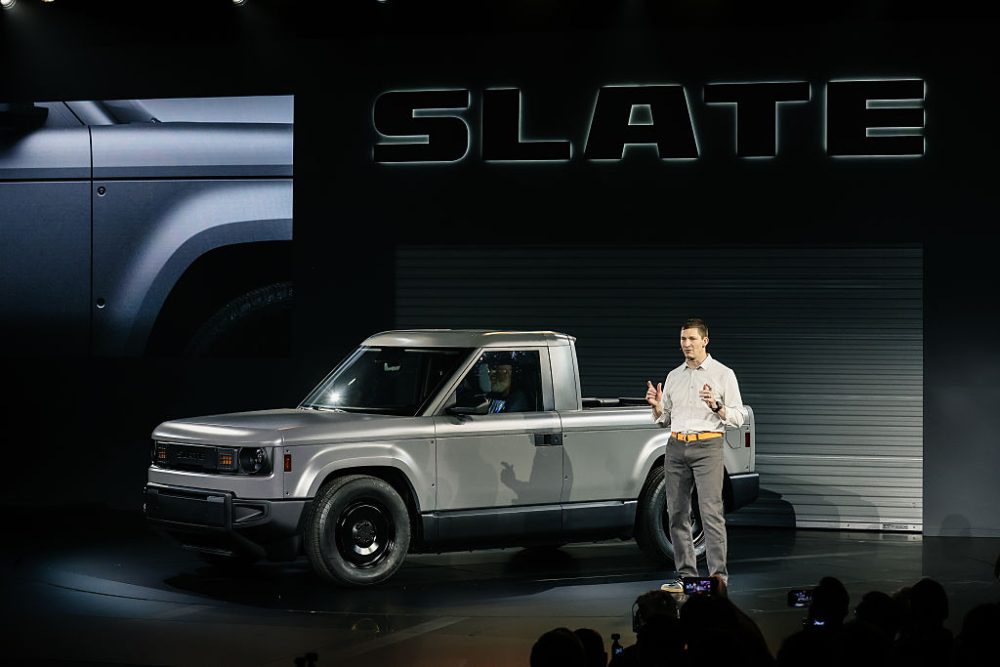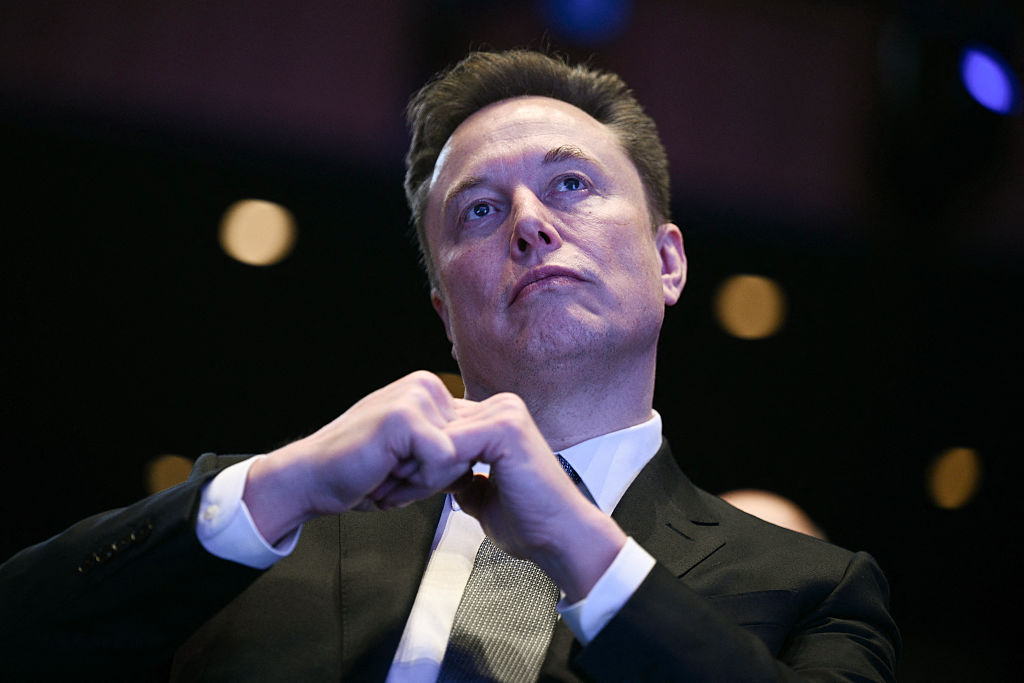Though it got somewhat lost in our daily swirl of World In Crisis, last week marked a potentially significant moment in American industry: the formal introduction of a new, low-cost US-based car company. This company is called Slate, mercifully no relation at all to the online magazine. The startup, significantly backed by Jeff Bezos, last week pulled the sheet off a $27,000 fully electric pickup truck, which should be available by the end of 2026.
The Slate Truck is significant for what it doesn’t have. The body is plastic, the manually adjustable seats cloth and it lacks electric windows. The driver will operate the windows with a manual crank. It has two doors, a 4×5 bed and black painted steel wheels. It comes in basic gray. If you want to customize color or design, that will be an upcharge for a “wrap”. Slate says that with tax credits, the base-model offer price will quickly dip below the coveted $20,000 threshold. You might even be able to buy it on Amazon.
“Not since cars from the 1990s has there been an interior so barren as the Slate Truck’s,” wrote Motor Trend, which has seen a lot of cars since the 1990s. “Physical switchgear is used throughout, including the climate control knobs and crank windows. Touchscreens are conspicuously absent.”
Slate plans for this truck to be customizable, like it comes from a kit. You can add rear seats and a “fastback bed cap,” turning it into a small SUV. Heated seats come extra. So do automatic windows and nicer interiors. But like basic economy seats on an airplane, whether or not you spring for the luxury upgrades, you can still get to your destination. The electric range is either 150 miles or 240 with a booster battery. That’s low for EVs these days, but Slate argues that for the vast majority of people, 150 miles a day is more than enough. They mean for this truck to drive around town, not from El Paso to Los Angeles.
This has been a long time coming for the automotive industry, which has struggled for a decade to respond to the innovations of Tesla, and, more recently, of several white-hot Chinese competitors. Legacy vehicle makers have produced some high-quality electric vehicles, but have mostly focused on tech-upgraded versions of what they already produce – an electric Audi, an electric Lexus, an electric Cadillac. But their efforts have mostly failed in the marketplace. The cars have been too fancy, too expensive, and sometimes just off the zeitgeist. Even the Ford F-150 Lightning, a high-quality electric version of the world’s best-selling truck, has had trouble finding buyers. At a $70,000 price point, that’s not surprising.
Slate took a different, ground-up, “Skunkworks” industrial approach, modeled on the way that Lockheed Martin developed a jet fighter for the United States during World War Two. The philosophy involves allowing a small group of highly-skilled people to operate outside the standard research and development procedures of an established industry. Slate CEO Chris Barman, a former high-ranking executive at Chrysler/FCA/Stellantis, described it to Inc. as “not having the encumbrances of a legacy business and doing it in a very innovative way, in a very scrappy way.” In other words, there’s no one saying “you can’t have hand-cranked windows.”
But maybe you can. Why not? Anyone who’s driven, or been driven in, a modern electric car knows that we live in an age of automotive miracles. Cars are faster, more efficient, and more comfortable than they’ve ever been, and are beginning to break out of a sclerotic age of industrial design. Fleets of automated taxis have begun to arrive in American cities. The future is here. But there’s one problem, or two interrelated problems. The first is that charging infrastructure, unless you own a Tesla or live in Norway or China, hasn’t caught up.
The second, more important one is that these cars are way too expensive. There’s not a single new vehicle in America on sale for less than $20,000. That price point is simply too high for the average buyer, which leads to people taking out brutal loans on new cars they can’t afford, or buying unreliable used junkers and praying they last a few years.
On the other hand, China’s biggest electric-car company, BYD, is currently offering its Seagull electric SUV for under $8,000 in its most bare-bones model. That’s less than a new HVAC system for your house in the USA. It costs more to renovate a bathroom. It’s a middle-class price point. Even the “flagship” BYD Han vehicle can sell for about $25,000.
Those Chinese cars will never appear on American shores. But that’s still a business strategy worth emulating and Slate is getting there. It’s not alone, either. Both General Motors and Toyota have set up skunkworks of their own and it’s almost certain that the rest of the industry is following suit.
Elon Musk was supposed to skunkwork the segment with the Cybertruck, or, as his millions of worldwide detractors call them, the “Swastikar.” The Cybertruck is far more interesting, if somewhat dystopian, to look at. It also retails from anywhere between $40,000 and $70,000, which means it didn’t really solve any problems, other than to provide some design cues for people who in the future want to make a 2024 nostalgia movie, or remake Demolition Man. With the Slate Truck, Jeff Bezos can stick it to his longtime adversary by making something affordable that protesters don’t want to set aflame. Your move, Elon.
Will Jeff Bezos steal Elon Musk’s electric crown with a $20,000 truck?
Your move, Elon

(Getty Images)
Though it got somewhat lost in our daily swirl of World In Crisis, last week marked a potentially significant moment in American industry: the formal introduction of a new, low-cost US-based car company. This company is called Slate, mercifully no relation at all to the online magazine. The startup, significantly backed by Jeff Bezos, last week pulled the sheet off a $27,000 fully electric pickup truck, which should be available by the end of 2026.The Slate Truck is significant for what it doesn’t have. The body is plastic, the manually adjustable seats cloth and it…

























Leave a Reply